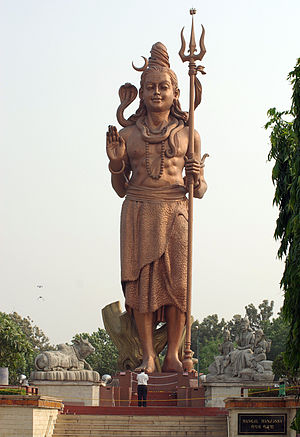Trishula
This article needs additional citations for verification. (March 2014) |
| Trishula | |
|---|---|
 Statue of Shiva holding a trishula in Delhi | |
| Type | Trident |
| Place of origin | South Asia |
| Service history | |
| Used by | Shiva, Durga, Kali, Prathyangira, Sarabh, Lavanasur, Ganesh, Shani, Mangal |
The Trishula ([त्रिशूल triśūla] Error: {{Lang-xx}}: text has italic markup (help), [त्रिशूल triśūl] Error: {{Lang-xx}}: text has italic markup (help), [त्रिशूळ triśūlla] Error: {{Lang-xx}}: text has italic markup (help), Malay: trisula, Kannada:ತ್ರಿಶೂಲ, "triśūla" Telugu:త్రిశూలం , trisoolam, Malayalam: തൃശൂലം tr̥iśūlaṁ, Tamil:// ⓘ திரிசூலம் tiricūlam, [ตรีศูล trīṣ̄ūl] Error: {{Lang-xx}}: text has italic markup (help) or tri) is a type of South Asian trident also found in Southeast Asia. It is commonly used as a Hindu-Buddhist religious symbol. The word means "three spear" in Sanskrit and Pali.
In India and Thailand, the term often refers to a short-handled weapon which may be mounted on a danda or staff. But unlike the Okinawan sai, the trishula is often bladed. In Malay and Indonesian, trishula usually refers specifically to a long-handled trident while the diminutive version is known as a chabang or tekpi.
Symbolism

The trishula symbolism is polyvalent and rich. [citation needed] The trishula is wielded by the Hindu God Shiva and is said to have been used to sever the original head of Ganesh. Durga also holds a trishula, as one of her many weapons. There are many other gods and deities, who hold the weapon trishula.[citation needed] The three points have various meanings and significance, and, common to Hindu religion, have many stories behind them. They are commonly said to represent various trinities—creation, maintenance and destruction, past, present and future, the three gunas.[citation needed] When looked upon as a weapon of Shiva, the trishula is said to destroy the three worlds: the physical world, the world of the forefathers (representing culture drawn from the past) and the world of the mind (representing the processes of sensing and acting). The three worlds are supposed to be destroyed by Shiva into a single non-dual plane of existence, that is bliss alone.[citation needed]
In the human body, the trishula also represents the place where the three main nadi, or energy channels (ida, pingala and shushmana) meet at the brow. Shushmana, the central one, continues upward to the 7th chakra, or energy center, while the other two end at the brow, there the 6th chakra is located.[citation needed] The trishula's central point represents Shushmana, and that is why it is longer than the other two, representing ida and pingala.[citation needed]
Other uses
- Trishula can sometimes also designate the Buddhist symbol of the triratna.
- The Goddess Durga holds a trishula among other weapons and attributes in her hands and amongst her accoutrement, having received celestial weapons from both Shiva and Vishnu.
- In Nepal, the trishula is the election symbol of the Communist Party of Nepal (United Marxist).[1]
- A similar word, Trishel, is the Romani word for 'cross'.
- In Yu-Gi-Oh!, "Trishula, Dragon of the Ice Barrier" and "Nekroz of Trishula" are monsters that can banish one card each from the opponent's hand (future), field (present), and Graveyard (past).
Gallery
-
Trishul brought as offerings to Guna Devi, near Dharamsala, Himachal Pradesh.
-
Emblem of the Chakri Dynasty, the royal house of Thailand founded in 1782. The emblem of the dynasty consists of the trisula intertwined with the Sudarshana Chakra, another weapon, to create a Chakri.
-
The Hachibushū Sendan Kendatsuba (or Candana Gandharva) is pictured killing several villains with his trishul in the collection of five paintings Extermination of Evil.


![A seven-pronged trishul on top of Wat Arun, a Buddhist temple, is also known as the "trident of Shiva"[2]](http://upload.wikimedia.org/wikipedia/commons/thumb/2/28/Wat-Arun-menorah-8845.jpg/90px-Wat-Arun-menorah-8845.jpg)



